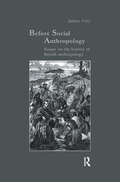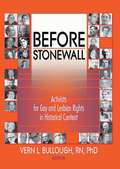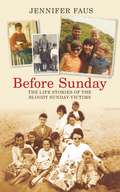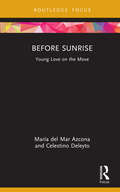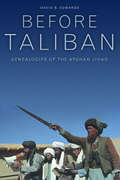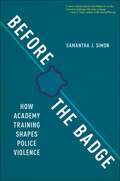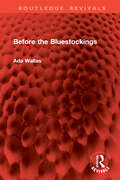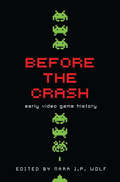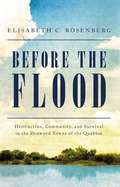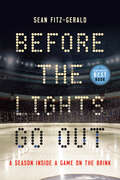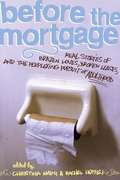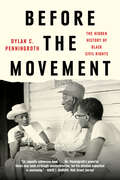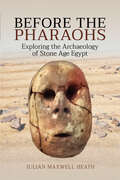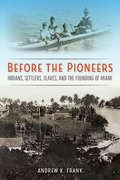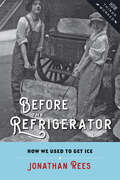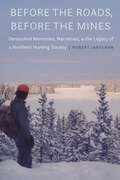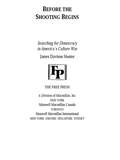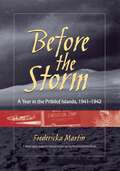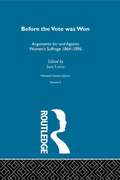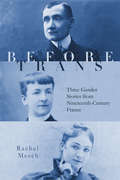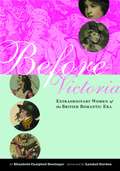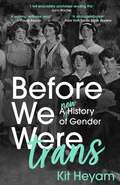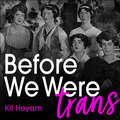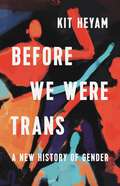- Table View
- List View
Before Social Anthropology: Essays on the History of British Anthropology (Studies in Anthropology and History)
by James UrryFirst Published in 1993. Routledge is an imprint of Taylor & Francis, an informa company.
Before Stonewall: Activists for Gay and Lesbian Rights in Historical Context
by Vern L BulloughExplore the early history of the gay rights movement!In the words of editor Vern L. Bullough: “Although there was no single leader in the gay and lesbian community who achieved the fame and reputation of Martin Luther King, there were a large number of activists who put their careers and reputations on the line. It was a motley crew of radicals and reformers, drawn together by the cause in spite of personality and philosophical differences. Their stories are told in the following pages.”Before Stonewall: Activists for Gay and Lesbian Rights in Historical Context illuminates the lives of the courageous individuals involved in the early struggle for gay and lesbian civil rights in the United States. Authored by those who knew them (often activists themselves), the concise biographies in this volume examine the lives of pre-1969 barrier breakers like Harry Hay, Henry Gerber, Alfred Kinsey, Del Martin, Phyllis Lyon, Jim Kepner, Jack Nichols, Christine Jorgensen, Jose Sarria, Barbara Grier, Frank Kameny, and 40 more. To anyone with an interest in the history of the gay/lesbian rights movements in the United States, these names will be familiar, but did you know that in addition to their groundbreaking activism: Prescott Townsend was a Boston Brahman Dorr Legg was a Log Cabin Republican Harry Hay was at one time a member of the Communist party Jim Kepner was a boy preacher Troy Perry was removed from the ministry of his church for homosexuality--and then founded the gay-friendly Metropolitan Community Church Reed Erickson--a transsexual millionaire who gave millions to the cause--kept a pet leopard called Henry Barbara Gittings set up a kissing booth at the American Library Association convention and urged attendees to kiss a gay or lesbian!Before Stonewall is a perfect ancillary text for any gay/lesbian studies course, but more to the point, no one interested in these heroic figures and the movements they ignited should be without this book, which received an honorable mention in the 2004 Stonewall Book Awards.
Before Sunday: The Life Stories of the Bloody Sunday Victims
by Jennifer FausIn this poignant account, we are introduced to the victims of the day that has come to be known as Bloody Sunday. On January 30th, 1972, the British Army deployed the 1st Parachute Regiment to conduct an arrest operation in Derry during a Northern Ireland Civil Rights Association march. Twenty-six civil rights protesters were shot, and 14 died--a photographer, a golfer, a student, a prankster, and 10 other boys and men who we learn are very much like any fathers, sons, brothers, and friends. Featuring personal and striking images, their stories will be of note to people all around the world.
Before Sunrise: Young Love on the Move (Cinema and Youth Cultures)
by María del Azcona Celestino DeleytoThis book offers a fresh analysis of Before Sunrise that reframes its romance within the contexts of transnational culture and cinema. The book highlights the symbolic value of the film’s construction of transnational youth in the building of a trans-European culture. Engaging with the film’s critical history, this book focuses on its specific view of youth and young love. Before Sunrise: Young Love on the Move examines young love within the cultural context of the 1990s in the US and its links with Generation X and the slacker culture. Within a wider scope, it also looks at the history and theory of romantic comedy and its connections with independent cinema. In considering the film a transnational text, this analysis underlines the parallels between a narrative of young love at the end of the 20th century and the construction of a young, or rejuvenated, Europe. Before Sunrise: Young Love on the Move provides an invaluable insight into this beloved film for students and researchers in film studies, transnational cinema and youth culture.
Before Taliban
by David B. EdwardsIn this powerful book, David B. Edwards traces the lives of three recent Afghan leaders in Afghanistan's history--Nur Muhammad Taraki, Samiullah Safi, and Qazi Amin Waqad--to explain how the promise of progress and prosperity that animated Afghanistan in the 1960s crumbled and became the present tragedy of discord, destruction, and despair. Before Taliban builds on the foundation that Edwards laid in his previous book, Heroes of the Age, in which he examines the lives of three significant figures of the late nineteenth century--a tribal khan, a Muslim saint, and a prince who became king of the newly created state. In the mid twentieth century, Afghans believed their nation could be a model of economic and social development that would inspire the world. Instead, political conflict, foreign invasion, and civil war have left the country impoverished and politically dysfunctional. Each of the men Edwards profiles were engaged in the political struggles of the country's recent history. They hoped to see Afghanistan become a more just and democratic nation. But their visions for their country were radically different, and in the end, all three failed and were killed or exiled. Now, Afghanistan is associated with international terrorism, drug trafficking, and repression. Before Taliban tells these men's stories and provides a thorough analysis of why their dreams for a progressive nation lie in ruins while the Taliban has succeeded. In Edwards's able hands, this culturally informed biography provides a mesmerizing and revealing look into the social and cultural contexts of political change.
Before the Badge: How Academy Training Shapes Police Violence
by Samantha J. SimonAn inside look at how police officers are trained to perpetuate state violenceMichael Brown. Philando Castile. George Floyd. Breonna Taylor. As the names of those killed by the police became cemented into public memory, the American public took to the streets in unprecedented numbers to mourn, organize, and demand changes to the current system of policing. In response, police departments across the country committed themselves to change, pledging to hire more women and people of color, incorporate diversity training, and instruct officers to verbally de-escalate interactions with the public.These reform efforts tend to rely on a “bad apple” argument, focusing the nature and scope of the problem on the behavior of specific individuals and rarely considering the broader organizational process that determines who is allowed to patrol the public and how they learn to do their jobs. In Before the Badge, Samantha J. Simon provides a firsthand look into how police officers are selected and trained, describing every stage of the process, including recruitment, classroom instruction, and tactical training.Simon spent a year at police academies participating in the training alongside cadets, giving her a visceral, hands-on understanding of how police training operates. Using rich and detailed examples, she reveals that the process does more than test a cadet’s physical or intellectual abilities. Instead, it socializes cadets into a system of state violence. As training progresses, cadets are expected to see themselves as warriors and to view Black and Latino/a members of the public as their enemies. Cadets who cannot or will not uphold this approach end up washing out. In Before the Badge, Simon explains how this training creates a context in which patterns of police violence persist and implores readers to re-envision the future of policing in the United States.
Before the Bluestockings (Routledge Revivals)
by Ada WallasFirst published in 1929, Before the Bluestockings is a study of the individual lives and the position of educated Englishwomen from the Restoration to the end of the first third of the eighteenth century. The question is approached not only from the women’s point of view—Hannah Woolley, Mary Astell and Elizabeth Elstob—but also records the views of contemporary observers like Lord Halifax, John Locke, George Ballard and Sir Richard Steele.
Before the Crash: Early Video Game History
by Mark J. P. WolfContributors examine the early days of video game history before the industry crash of 1983 that ended the medium's golden age.
Before the Flood: Destruction, Community, and Survival in the Drowned Towns of the Quabbin
by Elisabeth C. RosenbergIn the tradition of Silent Spring, a modern parable of the American experience and our paradoxical relationship with the natural world. Though it seems a part of the "natural" landscape of New England today, the Swift River Valley reservoir, dam, dike, and nature area was a triumph of civil engineering. It combined forward-looking environmental stewardship and social policy, yet the &“little people&”—and the four towns in which they lived—got lost along the way. Elisabeth Rosenberg has crafted Before the Flood to be both a modern and a universal story in a time when managed retreat will one day be a reality. Meticulously researched, Before the Flood, is the first narrative book on the incredible history of the Swift River Valley and the origins Quabbin Reservoir. Rosenberg dive into the socioeconomic and psychological aspects of the Swift River Valley&’s destruction in order to supply drinking water for the growing populations of Boston and wider Massachusetts. It is as much a human story as the story of water and landscape, and Before the Flood movingly reveals both the stories and the science of the key players and the four flooded towns that were washed forever away.
Before the Lights Go Out: A Season Inside a Game on the Brink
by Sean Fitz-GeraldA love letter to a sport that's losing itself, from one of Canada's best sports writers.Canadian hockey is approaching a state of crisis. It's become more expensive, more exclusive, and effectively off-limits to huge swaths of the potential sports-loving population. Youth registration numbers are stagnant; efforts to appeal to new Canadians are often grim at best; the game, increasingly, does not resemble the country of which it's for so long been an integral part. These signs worried Sean Fitz-Gerald. As a lifelong hockey fan and father of a young mixed-race son falling headlong in love with the game, he wanted to get to the roots of these issues. His entry point: a season with the Peterborough Petes, a storied OHL team far from its former glory in a once-emblematic Canadian city that is finding itself on the wrong side of the country's changing demographics. Fitz-Gerald profiles the players, coaches and front office staff, a mix of world-class talents with NHL aspirations and Peterborough natives happy with more modest dreams. Through their experiences, their widely varied motivations and expectations, we get a rich, colourful understanding of who ends up playing hockey in Canada and why. Fitz-Gerald interweaves the action of the season with portraits of public figures who've shaped and been shaped by the game: authors who captured its spirit, politicians who exploited it, and broadcasters who try to embody and sell it. He finds his way into community meetings full of angry season ticket holders, as well as into sterile boardrooms full of the sport's institutional brain trust, unable to break away from the inertia of tradition and hopelessly at war with itself. Before the Lights Go Out is a moving, funny, yet unsettling picture of a sport at a crossroads. Fitz-Gerald's warm but rigorous journalistic approach reads, in the end, like a letter to a troubled friend: it's not too late to save hockey in this country, but who has the will to do it?
Before the Mortgage
by Rachel Hutton Christina AminiThe swank apartment, the killer job, and the perfect boyfriend/girlfriend haven't yet fallen into place. Is this really adulthood? Welcome to life before the mortgage. Here's what you need to know. Christina Amini and Rachel Hutton have brought together the very best writing on this unpredictable -- and often hilarious -- time. This book features essays by celebrated writers such as Joel Stein, Thisbe Nissen, Thomas Beller, Found magazine's Davy Rothbart, and ReadyMade's Shoshana Berger, as well as exciting new writers.
Before the Movement: The Hidden History of Black Civil Rights
by Dylan C. Penningroth"Penningroth's conclusions emerge from an epic research agenda.... Before the Movement presents an original and provocative account of how civil law was experienced by Black citizens and how their 'legal lives' changed over time . . . [an] ambitious, stimulating, and provocative book." —Eric Foner, New York Review of Books Shortlisted for the Cundill History Prize Winner of the Merle Curti Social History Award from the Organization of American Historians Winner of the Ellis W. Hawley Prize from the Organization of American Historians Winner of the David J. Langum, Sr. Prize in American Legal History Winner of the James Willard Hurst Prize A prize-winning scholar draws on astonishing new research to demonstrate how Black people used the law to their advantage long before the Civil Rights Movement. The familiar story of civil rights goes like this: once, America’s legal system shut Black people out and refused to recognize their rights, their basic human dignity, or even their very lives. When lynch mobs gathered, police and judges often closed their eyes, if they didn’t join in. For Black people, law was a hostile, fearsome power to be avoided whenever possible. Then, starting in the 1940s, a few brave lawyers ventured south, bent on changing the law. Soon, ordinary African Americans, awakened by Supreme Court victories and galvanized by racial justice activists, launched the civil rights movement. In Before the Movement, acclaimed historian Dylan C. Penningroth brilliantly revises the conventional story. Drawing on long-forgotten sources found in the basements of county courthouses across the nation, Penningroth reveals that African Americans, far from being ignorant about law until the middle of the twentieth century, have thought about, talked about, and used it going as far back as even the era of slavery. They dealt constantly with the laws of property, contract, inheritance, marriage and divorce, of associations (like churches and businesses and activist groups), and more. By exercising these “rights of everyday use,” Penningroth demonstrates, they made Black rights seem unremarkable. And in innumerable subtle ways, they helped shape the law itself—the laws all of us live under today. Penningroth’s narrative, which stretches from the last decades of slavery to the 1970s, partly traces the history of his own family. Challenging accepted understandings of Black history framed by relations with white people, he puts Black people at the center of the story—their loves and anger and loneliness, their efforts to stay afloat, their mistakes and embarrassments, their fights, their ideas, their hopes and disappointments, in all their messy humanness. Before the Movement is an account of Black legal lives that looks beyond the Constitution and the criminal justice system to recover a rich, broader vision of Black life—a vision allied with, yet distinct from, “the freedom struggle.”
Before the Pharaohs: Exploring the Archaeology of Stone Age Egypt
by Julian Maxwell HeathAn examination of the Paleolithic and Neolithic communities that inhabited not only the Nile Valley and Delta, but also the Western and Eastern Deserts. The remarkable archaeology of pharaonic Egypt continues to captivate countless people worldwide but evidence for Egypt&’s prehistoric or Stone Age past has been relatively neglected. This is perhaps understandable, as the archaeology of Stone Age Egypt often seems crude in comparison, and the number of works published on the subject is diminutive compared to those dealing with the revered ancient civilization that emerged in the Nile Valley some five thousand years ago. However, although less spectacular, the numerous remnants of prehistoric life found throughout Egypt represent an important chapter in the story of humanity&’s distant past. They also cast compelling light on the shadowy Stone Age peoples who lived in the Nile Valley and surrounding deserts, long before the mighty monuments of the pharaohs ever existed. This book examines the fascinating archaeology of Stone Age Egypt, from its very beginnings, when early members of the human species arrived in Egypt from sub-Saharan Africa, to its end, when the impressive Naqada Culture emerged, setting in motion the processes that led to the formation of one of the world&’s greatest ancient civilizations. &“Before the Pharaohs is a well-written and informative study of the Egyptian stone age . . . You get the feeling reading this of being in the company of a knowledgeable and amiable tour guide.&” —Beating Tsundoku
Before the Pharaohs: Exploring the Archaeology of Stone Age Egypt
by Julian Maxwell HeathAn examination of the Paleolithic and Neolithic communities that inhabited not only the Nile Valley and Delta, but also the Western and Eastern Deserts. The remarkable archaeology of pharaonic Egypt continues to captivate countless people worldwide but evidence for Egypt&’s prehistoric or Stone Age past has been relatively neglected. This is perhaps understandable, as the archaeology of Stone Age Egypt often seems crude in comparison, and the number of works published on the subject is diminutive compared to those dealing with the revered ancient civilization that emerged in the Nile Valley some five thousand years ago. However, although less spectacular, the numerous remnants of prehistoric life found throughout Egypt represent an important chapter in the story of humanity&’s distant past. They also cast compelling light on the shadowy Stone Age peoples who lived in the Nile Valley and surrounding deserts, long before the mighty monuments of the pharaohs ever existed. This book examines the fascinating archaeology of Stone Age Egypt, from its very beginnings, when early members of the human species arrived in Egypt from sub-Saharan Africa, to its end, when the impressive Naqada Culture emerged, setting in motion the processes that led to the formation of one of the world&’s greatest ancient civilizations. &“Before the Pharaohs is a well-written and informative study of the Egyptian stone age . . . You get the feeling reading this of being in the company of a knowledgeable and amiable tour guide.&” —Beating Tsundoku
Before the Pioneers: Indians, Settlers, Slaves, and the Founding of Miami (Florida in Focus)
by Andrew K. Frank“In this riveting account, Frank moves beyond stories of recent development to uncover the deep history of a place profoundly shaped by mound-builders, slaves, raiders, and traders. This book will change the way you think about Florida history.”—Christina Snyder, author of Slavery in Indian Country: The Changing Face of Captivity in Early America “Reveals that Old Miami seems a lot like New Miami: a place bursting with energy and desperation, fresh faces, and ancient dreams.”—Gary R. Mormino, author of Land of Sunshine, State of Dreams: A Social History of Modern Florida “A deep, intelligent look at the parade of peoples who dotted the north bank of the Miami River for thousands of years before Miami’s modern era.”—Paul S. George, author of Along the Miami River “A masterful history. A must-read for anyone who wants to learn about Miami.”—Arva Moore Parks, author of George Merrick, Son of the South Wind Formed seemingly out of steel, glass, and concrete, with millions of residents from around the globe, Miami has ancient roots that can be hard to imagine today. Before the Pioneers takes readers back through forgotten eras to the stories of the people who shaped the land along the Miami River long before most modern histories of the city begin. Andrew Frank begins the chronicle of the Magic City’s long history 4,000 years ago when Tequesta Indians settled at the mouth of the river, erecting burial mounds, ceremonial centers, and villages. Centuries later, the area became a stopover for Spanish colonists on their way to Havana. Frank brings to life the vibrant colonies of fugitives and seafarers that formed on the shores of Biscayne Bay in the eighteenth century. He tells of the emergence of the tropical fruit plantations and the accompanying enslaved communities, as well as the military occupation during the Seminole Wars. Eventually, the small seaport town flourished with the coming of “pioneers” like Julia Tuttle and Henry Flagler who promoted the city as a place of luxury and brought new waves of residents from the North. Frank pieces together the material culture and the historical record of the Miami River to re-create the fascinating past of one of the world’s most influential cities. A volume in the series Florida in Focus, edited by Frederick R. Davis and Andrew K. Frank
Before the Refrigerator: How We Used to Get Ice (How Things Worked)
by Jonathan ReesA historical study of how increased access to ice—decades before refrigeration—transformed American life. During the late nineteenth and early twentieth centuries, Americans depended upon ice to stay cool and to keep their perishable foods fresh. Jonathan Rees tells the fascinating story of how people got ice before mechanical refrigeration came to the household. Drawing on newspapers, trade journals, and household advice books, Before the Refrigerator explains how Americans built a complex system to harvest, store, and transport ice to everyone who wanted it, even the very poor. Rees traces the evolution of the natural ice industry from its mechanization in the 1880s through its gradual collapse, which started after World War I. Meatpackers began experimenting with ice refrigeration to ship their products as early as the 1860s. Starting around 1890, large, bulky ice machines the size of small houses appeared on the scene, becoming an important source for the American ice supply. As ice machines shrunk, more people had access to better ice for a wide variety of purposes. By the early twentieth century, Rees writes, ice had become an essential tool for preserving perishable foods of all kinds, transforming what most people ate and drank every day. Reviewing all the inventions that made the ice industry possible and the way they worked together to prevent ice from melting, Rees demonstrates how technological systems can operate without a central controlling force. Before the Refrigerator is ideal for history of technology classes, food studies classes, or anyone interested in what daily life in the United States was like between 1880 and 1930.&“An in-depth portrayal of a once-indispensable, life-changing technology, the former existence of which is as unknown to most of us as that of the telegraph or canal is to today&’s undergraduates. . . . Rees synthesizes considerable archival research and presents interpretations of importance to scholars. . . . Before the Refrigerator is as refreshing as ice water on a hot summer day.&” —Journal of American History&“This fact-filled book explains how ice became an American necessity by the early twentieth century. Students in business history and history of technology courses will be fascinated to learn how macrobreweries made lager into America&’s favorite beer, how cocktails became commonplace, and how burly men used to lug giant blocks of ice into American kitchens.&” —Shane Hamilton, author of Trucking Country: The Road to America&’s Wal-Mart Economy
Before the Roads, Before the Mines: Denesuliné Memories, Narratives, and the Legacy of a Northern Hunting Society
by Robert JarvenpaBefore the Roads, Before the Mines is a narrative-based ethnohistory of a Denesułiné community, also known as the Chipewyan, Kesyehot&’ine, or Poplar House People. The discovery of high-grade uranium deposits in northern Saskatchewan, Canada, in the mid- to late 1970s ushered in an era of mining and roadbuilding that largely replaced the traditional livelihoods of these subarctic hunter-fishers with wage labor in mining, construction, and related industries. The advent of new communications technologies and consumer goods, and a road to the outside world, created ruptures in the social fabric of the community. Robert Jarvenpa highlights the historical experiences of middle-aged and older individuals who vividly recall a time before the roads and mines existed—when young and old alike spoke the Denesułiné language and when entire families lived in a seasonally nomadic fashion in the bush. They continually invoke the past in the problematic present, a ritualized form of communication integral to resisting or adapting to the erosive changes of a rapidly industrializing resource-extraction frontier. Jarvenpa showcases the spoken words of the Denesułiné informants as a means of documenting and interpreting their historical past in the face of contemporary peril as the subarctic permafrost recedes and multinational corporations eye Indigenous lands for their minerals.
Before the Shooting Begins
by James Davidson HunterAddressing America's cultural conflict about such issues as abortion, homosexuality, and family values, the author presents a plan in which America can achieve a renewed democracy, despite these differences.
Before the Storm: A Year in the Pribilof Islands, 1941–1942
by Fredericka MartinAn account of the struggles and oppression of the Pribilof Aleuts of Alaska written by a woman who became their passionate advocate.From June of 1941 through the following summer, Fredericka Martin lived with her husband, Dr. Samuel Berenberg, on remote St. Paul Island in Alaska. During that time, Martin delved into the complex history of the Unangan people, and Before the Storm draws from her personal accounts of that year and her research to present a fascinating portrait of a time and a people facing radical change. A government-ordered evacuation of all Aleuts from the island in the face of World War II, which Martin recounts in her journal, proved but the first step in a long struggle by native peoples to gain independence, and, as editor Raymond L. Hudson explains, Martin came to play a significant role in the effort.&“Particularly because so few books about the Pribilofs have focused on the people of the islands, Before the Storm offers an especially welcome perspective to our understanding of the unusual history of the Aleuts there.&” —Alaska Journal of Anthropology
Before the Vote was Won: Arguments For And Against Women's Suffrage (Women's Source Library #Vol. 5)
by Jane LewisFirst published in 1987. This volume traces the arguments of early suffragists through the last three decades of the nineteenth century. Includes the texts of the House of Commons Debate on the 1871 Disabilities Bill, 1982 Women's Franchise Bill and key documents by those who were opposed to women's suffrage
Before Trans: Three Gender Stories from Nineteenth-Century France
by Rachel MeschA fascinating exploration of three individuals in fin-de-siècle France who pushed the boundaries of gender identity. Before the term "transgender" existed, there were those who experienced their gender in complex ways. Before Trans examines the lives and writings of Jane Dieulafoy (1850–1916), Rachilde (1860–1953), and Marc de Montifaud (1845–1912), three French writers whose gender expression did not conform to nineteenth-century notions of femininity. Dieulafoy fought alongside her husband in the Franco-Prussian War and traveled with him to the Middle East; later she wrote novels about girls becoming boys and enjoyed being photographed in her signature men's suits. Rachilde became famous in the 1880s for her controversial gender-bending novel Monsieur Vénus, published around the same time that she started using a calling card that read "Rachilde, Man of Letters." Montifaud began her career as an art critic before turning to erotic writings, for which she was repeatedly charged with "offense to public decency"; she wore tailored men's suits and a short haircut for much of her life and went by masculine pronouns among certain friends. Dieulafoy, Rachilde, and Montifaud established themselves as fixtures in the literary world of fin-de-siècle Paris at the same time as French writers, scientists, and doctors were becoming increasingly fascinated with sexuality and sexual difference. Even so, the concept of gender identity as separate from sexual identity did not yet exist. Before Trans explores these three figures' lifelong efforts to articulate a sense of selfhood that did not precisely align with the conventional gender roles of their day. Their intricate, personal stories provide vital historical context for our own efforts to understand the nature of gender identity and the ways in which it might be expressed.
Before Victoria: Extraordinary Women of the British Romantic Era
by Elizabeth DenlingerIt might not have the been the revolution that Mary Wollstonecraft called for in A Vindication of the Rights of Woman (1792), but the Romantic era did witness a dramatic change in women's lives. Combining literary and cultural history, this richly illustrated volume brings back to life a remarkable, though frequently overlooked, group of women who transformed British culture and inspired new ways of understanding feminine roles and female sexuality. What was this revolution like? Women were expected to be more moral, more constrained, and more private than in the eighteenth century, when women such as Georgiana Cavendish, Duchess of Devonshire crafted bold public personas. Genteel women no longer laughed aloud at bawdy jokes and noblewomen ran charity bazaars instead of private casinos. By 1800, motherhood had become a sacred calling and women who could afford to do so devoted themselves to the home. While this idealization of domesticity kept some women off the streets, it afforded others new opportunities. Often working from home, women wrote novels and poetry, sculpted busts, painted portraits, and conducted scientific research. They also seized the chance to do good, and crafted new public roles for themselves as philanthropists and reformers. Now-obscure female astronomers, photographers, sculptors, and mathematicians share these pages with celebrated writers such as Mary Shelley, her mother Mary Wollstonecraft, and Mary Robinson, who in addition to being a novelist and actress was also the mistress of the Prince of Wales. This book also makes full use of The New York Public Library's extensive collections, including graphic works and caricatures from the late eighteenth and early nineteenth centuries, manuscripts, hand-colored illustrations, broadsides, drawings, oil paintings, notebooks, albums and early photographs. These vivid, beautiful, and often humorous images depict these women, their works, and their social and domestic worlds.
Before We Were Trans: A New History of Gender
by Dr Kit Heyam'A beautiful, brilliant, lively book that weaves together fascinating and moving examples with thoughtful analysis. Both heartfelt and rigorous, entertaining and scholarly, Before We Were Trans invites us to expand our sense of communities - past and present - in welcoming ways, rather than contracting them and policing their borders' MEG-JOHN BARKER, author of Gender: A Graphic Guide'Celebrates trans history, whilst acknowledging the reality of what it means to live within our community with joy and kindness. In-depth research and personal stories tie Before We Were Trans up into a true treat for the mind' JAMIE WINDUST, author of In Their ShoesAcross the world today, people of all ages are doing fascinating, creative, messy things with gender. These people have a rich history - but one that is often left behind by narratives of trans lives that focus on people with stable, binary, uncomplicated gender identities. As a result, these stories tend to be recent, binary, stereotyped, medicalised and white.Before We Were Trans is a new and different story of gender, that seeks not to be comprehensive or definitive, but - by blending culture, feminism and politics - to widen the scope of what we think of as trans history by telling the stories of people across the globe whose experience of gender has been transgressive, or not characterised by stability or binary categories. Transporting us from Renaissance Venice to seventeenth-century Angola, from Edo Japan to North America, the stories this book tells leave questions and resist conclusions. They are fraught with ambiguity, and defy modern Western terminology and categories - not least the category of 'trans' itself. But telling them provides a history that reflects the richness of modern trans reality more closely than any previously written. Before We Were Trans is a history and celebration of gender in all its fluidity, ambiguity and complexity.
Before We Were Trans: A New History of Gender
by Dr Kit HeyamA globe-spanning, different and vital new history of gender.Across the world today, people of all ages are doing fascinating, creative, messy things with gender. These people have a rich history - but one that is often left behind by narratives of trans lives that focus on people with stable, binary, uncomplicated gender identities. As a result, these stories tend to be recent, binary, stereotyped, medicalised and white.Before We Were Trans is a new and different story of gender, that seeks not to be comprehensive or definitive, but - by blending culture, feminism and politics - to widen the scope of what we think of as trans history by telling the stories of people across the globe whose experience of gender has been transgressive, or not characterised by stability or binary categories. Transporting us from Renaissance Venice to seventeenth-century Angola, from Edo Japan to North America, the stories this audiobook tells leave questions and resist conclusions. They are fraught with ambiguity, and defy modern Western terminology and categories - not least the category of 'trans' itself. But telling them provides a history that reflects the richness of modern trans reality more closely than any previously written. Before We Were Trans is a history and celebration of gender in all its fluidity, ambiguity and complexity.(P) 2022 Hodder & Stoughton Limited
Before We Were Trans: A New History of Gender
by Dr. Kit HeyamA groundbreaking global history of gender nonconformity Today&’s narratives about trans people tend to feature individuals with stable gender identities that fit neatly into the categories of male or female. Those stories, while important, fail to account for the complex realities of many trans people&’s lives. Before We Were Trans illuminates the stories of people across the globe, from antiquity to the present, whose experiences of gender have defied binary categories. Blending historical analysis with sharp cultural criticism, trans historian and activist Kit Heyam offers a new, radically inclusive trans history, chronicling expressions of trans experience that are often overlooked, like gender-nonconforming fashion and wartime stage performance. Before We Were Trans transports us from Renaissance Venice to seventeenth-century Angola, from Edo Japan to early America, and looks to the past to uncover new horizons for possible trans futures.
